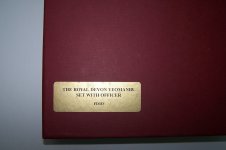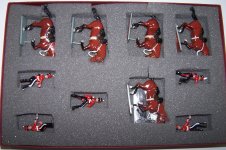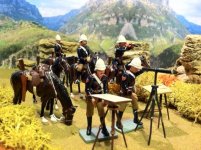Re: HM of Great Britain - Equine Glossary
Horsey Bits Glossary Hope this helps
 Artificial Aids:
Artificial Aids: Mechanical means by which the rider conveys his wishes to the horse. Includes spurs and whip.
Bat: Artificial aid by which the rider may emphasize and back up the natural aids of seat and legs. Used to encourage reluctant or lazy horses to move forward. Sometimes used to punish. See also whip and crop.
Bearing Rein: Neck rein - rein pushed against neck in direction of turn.
Bight of the Reins: The part of the reins passing between thumb and fingers and out the top of the hand.
Billets/Billet Straps: Straps by which the girth is attached to the saddle.
Bit: Mouthpiece, made of metal but may be made of rubber or other manmade material and held in place by the bridle, by which the rider conveys instructions to the horse.
Bitting Rig: A combination of bridle, harness pad, and crupper. Used to teach horse to flex at the poll.
Bridle: Item of equipment worn on the horse's head, enabling the rider to communicate his wishes through use of the bit and the reins.
Blinders: Small pieces of leather that are attached to the bridle to disable a horse from seeing behind themselves without getting close to the eyes or limiting other vision
Cantle: Back ridge of an English saddle.
Carriage: A vehicle that is pulled by a horse to transport the driver and possibly other passengers.
Cavesson: Simple noseband fitted to a bridle. Or: Leather or nylon headgear, with attachments for side reins and lunge line, worn by the horse when it is being lunged.
Center fire: A western saddle with cinch hung from center.
Chaps: Seatless overalls made of leather, sometimes fur covered, for protection when riding in brush or for protection from cold.
Cinch: Means by which a Western saddle is secured to the horse, which attaches to the saddle on one side, running under the barrel just behind the legs to the other side. Called a girth in English Riding.
Corona: Saddle pad cut to fit shape of saddle; has a large colorful roll around edge.
Crop: Artificial aid by which the rider may emphasize and back up the natural aids of seat and legs. Used to encourage reluctant or lazy horses to move forward. Sometimes used to punish. See also whip and bat.
Cross reins: Method of holding single reins where reins overlap in hands across horse's neck.
Cross-Ties: A method of tethering a horse using two ropes or ties, one on each side, connected to a solid post or wall.
Curb Bit: Bit fitted with cheeks and a curb chain, which lies in the chin groove. Operates on the leverage principle acting on the lower jaw. In a double bridle, the curb bit is used in conjunction with a bridoon, or snaffle bit.
Curb Chain: Chain used with a curb bit.
Direct Reining: Controlling a horse by pulling directly on the reins with one hand on each rein.
Double Bridle: Traditional English bridle with two bits (snaffle and curb) giving the rider a greater degree of control than a single bit.
Draw Rein: A rein, which attaches to the girth at one end, passes through the rings of the bit and back to the rider's hands. Used to increase control and give a better head position but is difficult to use correctly and is very easy to abuse.
Dropped or Drop Noseband: Noseband which buckles beneath the bit to prevent the horse from opening its mouth to "take hold of" the bit and ignore the rider's rein aids.
Fiadore: A special knot on the hackamore that exerts pressure at the rear of jaws.
Figure-Eight Noseband: (Also called a Grackle noseband.) Noseband with thin leather straps, which cross over at the front and buckle both above and below the bit.
Girth: Means by which an English saddle is secured to the horse, which attaches to the saddle on one side, running under the barrel just behind the legs to the other side. Called a cinch in Western Riding.
Grackle Noseband: (Also called a Figure-Eight noseband.) Noseband with thin leather straps, which cross over at the front and buckle both above and below the bit.
Hackamore: A bitless bridle of various designs used in breaking and training.
Hames: Metal arms fitted into the harness collar and linked to the traces.
Harness: Term for the equipment of a horse that is driven, as opposed to being ridden.
Head stall: The leather bridle straps exclusive of bit and reins.
Hobble: Straps fastened to the front legs of a horse to prevent him from straying from camp.
Horn: Prominent pommel at the front of a western saddle around which the rider loops or twists the lariat when a steer has been roped to secure the animal. See also Saddle Horn.
Honda: A ring of rope, rawhide, or metal on a lasso through which the loop slides.
Irons: The metal pieces attached to the saddle by means of leather straps in which the rider places his feet. (See also Stirrups.)
Jockey: The leather flaps on the side of a saddle.
Lariat: A rope, often of rawhide, with running noose, used for catching cattle.
Lead Strap: A strap or rope attached to the halter for leading.
Lead: Term used to indicate the horse's leading leg in canter i.e. "right lead canter" or "left lead canter."
Lead Rope: A rope, which attaches to the halter, that is used to lead a horse.
Leopard: A rope, which attaches to the halter that is used to lead or tie a horse with.
Longe or Lunge: The act of training a horse by working it in the various paces on a circle using a long longe or lunge rein. This rein is attached to the cavesson. Also novice riders may have their first lessons on the lunge as they learn the basics of position, without having to concern themselves with the control of the horse.
Mecate: A hackamore lead rope.
Neck Reining: The art of turning the horse by using the indirect, or opposite rein against the neck.
Neck Strap: Simple leather strap bucked around the horse's neck to give security to novice riders. Also refers to that part of a martingale, which buckles around the horse's neck.
Pelham: Curb bit with a single mouthpiece to which two reins may be attached. Aims to combine the two bits of a double bridle into a single mouthpiece.
Port: Raised section in the center of the mouthpiece on some curb bits. The amount it is raised affects the severity of the bit (low ported bits being milder).
Pommel: The center front of an English saddle. In some designs the pommel is cut back.
Polo Chain: A chin chain of flat, large links.
Romal: A length of braided rawhide attached to the end of connected reins.
Rosin: Is used on the rider's shoes to increase the grip.
Rowels: The toothed wheels on spurs.
Saddle Horn: Prominent pommel at the front of a Western saddle around which the rider loops or twists the lariat when a steer has been roped to secure the animal. See also Horn.
Side Reins: Reins used in training to help position the horse's head. They attach at one end to the bit and to the girth or to the training surcingle at the other end.
Snaffle (bit): Design of bit that acts on the corners or bars of the horse's mouth. May be jointed or straight, but does not have shanks and only uses one rein.
Split Reins: Reins with unconnected ends.
Spurs: Small metal devices worn on the rider's boot to help enforce the leg aids.
Surcingle: Webbing strap which passes around the horse's barrel. Can be used to attach side reins to when lunging young horses. Show jumpers, jockeys, and eventers use them over the saddle as an added precaution against the girth breaking. Also used over blankets/rugs.
Tack Up: To put on bridle and saddle.
Tack: Refers to the equipment of a riding horse - saddle, bridle, etc. Short for "tackle."
Tapadera: Stirrup cover.
War bridle: An emergency bridle made of rope.











